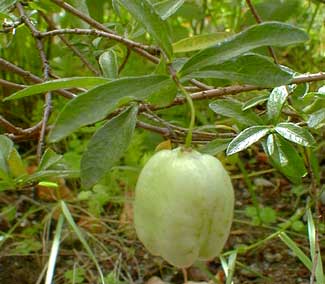
White Climbing Apple Berry
I said, "What influence me preferred
Elect to dreams thus beautiful?
"
The vines replied, "And didst thou deem
No wisdom to our berries went?"
-Ralph Waldo Emerson
(1803-1882)
(1803-1882)
There are eight species of Billardiera in Tasmania & New South Wales, Australia, but so far only B. longiflora is much available in the US. Its most common color is the bluish purple appleberry, but it has a few cultivars which produce the seedy fruits in sundry color variations, from sundry shades of purple to rosy pink to pure white. The varieties grow true from the seeds or can be propagated from cuttings.
The white form B. longiflora var fructu-albo occurs naturally in Tasmania on Mount Wellington. It can be a little less vigorous than the purple appleberry.
It has tubular pale yellow-green flowers in spring & half-inch round fruits by July. These will remain on the vines right up to winter if left for their ornamental qualities, but can be picked when still young to use in the kitchen. They have a flavor reminiscent of apple & a texture somewhat like eggplant, & are tastiest cooked like the tiniest of eggplants. Once they have been on the vine for a while, however, they are too flavorlessly seedy to be eaten.
Ripened seed will grow immediately & rapidly if planted quickly after harvest without drying. They can also be dried & stored a short while, but dried seed can take a year to germinate when finally planted. New plants are also easily propagated from layering or stem cuttings.
This tiny-leafed cool climate evergreen climber likes bright shade to full sun. It can climb or scramble to eight or nine feet, but is often smaller, & is easily kept smaller with spring or autumn pruning. It can be trellised or trained to climb a fence or climb into the branches of a loosely limbed shrub or dwarf tree. Organically rich moist well-draining soil is best, though when established it is somewhat drought hardy.
The leaves contain saponins sufficiently toxic that the vines are not much bothered by insect pests or rabbits. The toxicity is extremely slight to mammals including people, but fish can be very susceptible, so that tribal peoples of Tasmania & Australia formerly caught fish by placing copious amounts appleberry leaves in the water to intoxicate fish & render them easily gathered.
Only mildly frost-tolerant, appleberry rarely fares well below Zone 7/8, but can be grown in warmer areas (to Zone 9 certainly, possibly Zone 10) with persistent moisture & protection especially of the root system from too much heat from direct exposure to the sun's radiation, including a pale mulch in winter. Where summers are longest it does less well than where winters are long, mild, cool, & wet.